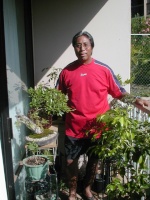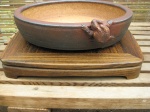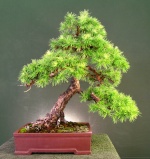Bristlecone Pines
+5
Todd Ellis
TheMulletRapper
craigw
Hawaiian77
fredtruck
9 posters
Page 1 of 1
 Bristlecone Pines
Bristlecone Pines
In mid-September, I had the good fortune to photograph bristlecone pines in Cedar Break, Utah, here in the U.S. Cedar Break is a National Monument, a step down in size from a National Park. A "break" is another word for badlands, so Cedar Break is a badlands near Cedar City, Utah.
Because this park is so remote, the bristlecone pines there are rarely visited and even more rarely photographed. Cedar Break is almost 2 miles high, so for the most part, people who visit are dedicated hikers.
But I came to take pictures of these wonderful trees, the oldest of which is about 1,650 years old. For bonsai enthusiasts I think there are a few things to notice. First, bristlecones almost all begin as single trunk trees, but due to injury, almost all old ones are multiple trunk. The deadwood is fabulous, but it is not the high white of lime sulphur nor is it a dull grey, but full of color due to the resin.
Finally, please enjoy my pictures.
http://www.flickr.com/photos/32652998@N04/sets/72157624985596539/
Because this park is so remote, the bristlecone pines there are rarely visited and even more rarely photographed. Cedar Break is almost 2 miles high, so for the most part, people who visit are dedicated hikers.
But I came to take pictures of these wonderful trees, the oldest of which is about 1,650 years old. For bonsai enthusiasts I think there are a few things to notice. First, bristlecones almost all begin as single trunk trees, but due to injury, almost all old ones are multiple trunk. The deadwood is fabulous, but it is not the high white of lime sulphur nor is it a dull grey, but full of color due to the resin.
Finally, please enjoy my pictures.
http://www.flickr.com/photos/32652998@N04/sets/72157624985596539/
fredtruck- Member
 Re: Bristlecone Pines
Re: Bristlecone Pines
Howzit Fredtruck
That was very interesting and beautiful. Mahalo for sharing. I love the way nature plays her hand in shaping her trees.
Mahalo for sharing. I love the way nature plays her hand in shaping her trees. 
A Hui Hou,
-Tim
That was very interesting and beautiful.
 Mahalo for sharing. I love the way nature plays her hand in shaping her trees.
Mahalo for sharing. I love the way nature plays her hand in shaping her trees. A Hui Hou,
-Tim

Hawaiian77- Member
 Re: Bristlecone Pines
Re: Bristlecone Pines
I think I read somewhere that, instead of the usual 2 or 3 year cycle for needles, the Bristlecone keeps them for 40 years. Amazing trees and photos.
Guest- Guest
 Re: Bristlecone Pines
Re: Bristlecone Pines
Thank you very much. I really enjoyed taking the pictures, and am pleased when other people enjoy them, too.
There is this book on bristlecones that I can't recommend enough. It's "The Bristlecone Book," by Ronald M. Lanner. He says bristlecones keep their needles 45 years.
There is this book on bristlecones that I can't recommend enough. It's "The Bristlecone Book," by Ronald M. Lanner. He says bristlecones keep their needles 45 years.
fredtruck- Member
 bristlecone bonsai
bristlecone bonsai
They seem to be very promising. There is a variety, "Sherwood's Compacta" which is very dwarf and fuil.
Reasons they attract me, other than their impressive portfolio in the wild, include the longevity of the needles and the tendency to pop branches everywhere, not just in whorls. This makes them much more manageable. For a few years, I had gotten wonderful stock from Greer Gardens: full and flexible. But the last one was a dog, with no opportunities and a lot of dead branches. Anyone have sources?
I note that the ones in the White Mountains are growing in dolomite, an alkaline medium.
I have lost several nice ones during transplanting, but the last one is doing fine.
I will try to post some photos.
Reasons they attract me, other than their impressive portfolio in the wild, include the longevity of the needles and the tendency to pop branches everywhere, not just in whorls. This makes them much more manageable. For a few years, I had gotten wonderful stock from Greer Gardens: full and flexible. But the last one was a dog, with no opportunities and a lot of dead branches. Anyone have sources?
I note that the ones in the White Mountains are growing in dolomite, an alkaline medium.
I have lost several nice ones during transplanting, but the last one is doing fine.
I will try to post some photos.
TheMulletRapper- Member
 Lower Elevation
Lower Elevation
I also read a book about the Bristlecone Pine, A Garden of Bristlecones; Tales of Change in the Great Basin, by Michael P. Cohen. Sadly, I do not know when it was published. I recall it being a wonderful read and full of intriguing information, though it was way back in 2005, so most of the details have escaped me by now. However, I do recall reading therein that bristlcone pines relatively thrive at somewhat lower elevations in the same region. At those lower elevations they are intermixed with and sometimes confused for Jeffrey pines. The iconic contortions of the bristlecone result from the genuinely severe conditions under which those trees in the higher elevations are able to survive. Those trees, particularly those that are among the oldest, are threatened by changing weather, and therefore precipitation, patterns. To upset the rhythm upon which these trees have come to rely is unsettling, one of several indicators of who knows what. Your photographs, beautiful as they are, tell a story, I think, that is about more than the bristlcones. That is to say, are all of those stands of grey, dead trees bristlecones? Or are there other species mixed in those stands as well? I bring this up because I suspect most of us who pursue and love bonsai have an abiding respect and affection for the wild side of life that we try (some of us [me] way less than everyone else [you]) to portray in miniature. If our collective behavior upsets that which we would emulate, we have (again collectively, which goes way beyond just bonsai nuts like us) committed a disgraceful and regrettable, though not wholly irretrievable, act. Life does, after all, go on...and change.
Another thing I seem to recall from Cohen's book is that some of these old bristlecones may be as much as 3,000 to 5,000 years old, considerably older than the 2,000 year old, 300+ foot tall Coast Redwoods of the place I call home. I may be mistaken in that exact figure, but I'm sure the oldest were around before the commencement of our current dating system.
To bring this discussion back to bonsai, I acquired some seed claiming to be bristlecone, Jeffrey, and black pine from some internet seed seller, sprouted them, and, because I was in the middle of my university career (circa 2003-2005), proceeded to mismanage them, killing some, shuffling others, probably simply misplacing of leaving behind a few, moving from one residence to another at least once a year for a while. I'm sad it has been such a difficult road for my trees and me; the story could be a memoir of hilarity and heartbreak depending on the page and your stronger orientation (trees or people). The result is that I now have a number of pines that I'm having a difficult time identifying. They are planted together, but mixed, and some of them are even planted with deciduous trees. I'm finally settling down considerably more, and I am more able now to care for them and look out for their health, which means I may be able to think about showing them someday. Though, as I primarily train them for my own personal fulfillment, there is little need for me to really identify or show them except to keep them healthy and vigorous.
I guess this brings me to a question I've been brewing for the past few minutes as I rambled on: do you recommend that I enter trees in local or regional contests? I've often been tempted to contact my local bonsai club, but there is a reigning timidity in me. Would this really help me improve my skills more than spending long nights at my low-stress job reading about and observing photographs of bonsai on the internet?
I'm afraid I've rambled, and for that I apologize. However, I hope you enjoyed it and that you can offer some insight into my conundrums and apprehension.
Thank you,
Jeff
P.S. Thank you to the previous two posters for commenting on the original post, making this a relevant train of thought for me to pursue.
Another thing I seem to recall from Cohen's book is that some of these old bristlecones may be as much as 3,000 to 5,000 years old, considerably older than the 2,000 year old, 300+ foot tall Coast Redwoods of the place I call home. I may be mistaken in that exact figure, but I'm sure the oldest were around before the commencement of our current dating system.
To bring this discussion back to bonsai, I acquired some seed claiming to be bristlecone, Jeffrey, and black pine from some internet seed seller, sprouted them, and, because I was in the middle of my university career (circa 2003-2005), proceeded to mismanage them, killing some, shuffling others, probably simply misplacing of leaving behind a few, moving from one residence to another at least once a year for a while. I'm sad it has been such a difficult road for my trees and me; the story could be a memoir of hilarity and heartbreak depending on the page and your stronger orientation (trees or people). The result is that I now have a number of pines that I'm having a difficult time identifying. They are planted together, but mixed, and some of them are even planted with deciduous trees. I'm finally settling down considerably more, and I am more able now to care for them and look out for their health, which means I may be able to think about showing them someday. Though, as I primarily train them for my own personal fulfillment, there is little need for me to really identify or show them except to keep them healthy and vigorous.
I guess this brings me to a question I've been brewing for the past few minutes as I rambled on: do you recommend that I enter trees in local or regional contests? I've often been tempted to contact my local bonsai club, but there is a reigning timidity in me. Would this really help me improve my skills more than spending long nights at my low-stress job reading about and observing photographs of bonsai on the internet?
I'm afraid I've rambled, and for that I apologize. However, I hope you enjoyed it and that you can offer some insight into my conundrums and apprehension.
Thank you,
Jeff
P.S. Thank you to the previous two posters for commenting on the original post, making this a relevant train of thought for me to pursue.
Last edited by j4561eff on Fri Apr 06, 2012 3:37 am; edited 1 time in total (Reason for editing : Added a P.S.)

j4561eff- Member
 bristlecones as bonsai
bristlecones as bonsai
I picked up one clue from the White Mountain bristlecones (which are Pinus longaeva, not aristata. The latter grow in Colorado, and apparently don't have the flecks of resin on their needles). They are growing in pure white dolomite, which is alkaline. The two i was growing perked up when I worked some crushed dolomite into their soil. I get it a a marine aquarist's shop, and I use it with my junipers, too, replacing half the grit with it.
My favorite book of bristlecone photos is "Timberline Ancients".
My favorite book of bristlecone photos is "Timberline Ancients".
TheMulletRapper- Member
 Re: Bristlecone Pines
Re: Bristlecone Pines
I ran across two of these pines recently as bonsai and was quite enamoured of them. So naturally I had to find me one. So I found two and intend to work with them. So was hopefull to learn more about them as bonsai. Not too mch information. Both these trees were chuhin sized, been around in the owner's hands with no problem. Tho I didn't have a lengthy conversation, the sense i had was that they created no problems being maintained here in the Pacific Northwest.
If anyone else has anything to contribute, I'd appreciate it.
If anyone else has anything to contribute, I'd appreciate it.

dick benbow- Member
 Re: Bristlecone Pines
Re: Bristlecone Pines
Thanks for sharing pictures. I wouldn't hesitate to take such trip too. It must be highly educative and inspiring .

yamasuri- Member
 Re: Bristlecone Pines
Re: Bristlecone Pines
Dan Robinson, it was recounted in his book that Kimura, on a trip to the US, insisted on seeing Bristlecone pines in nature.

Twisted Trees- Member
 Similar topics
Similar topics» Bristlecone Pines, General Advice
» Bristlecone Pine (pinus aristata) nursery stock
» 1.5 year old Pinus Aristata, Too dry? Or on track?
» Getting some pines
» my first japanese black pine
» Bristlecone Pine (pinus aristata) nursery stock
» 1.5 year old Pinus Aristata, Too dry? Or on track?
» Getting some pines
» my first japanese black pine
Page 1 of 1
Permissions in this forum:
You cannot reply to topics in this forum






